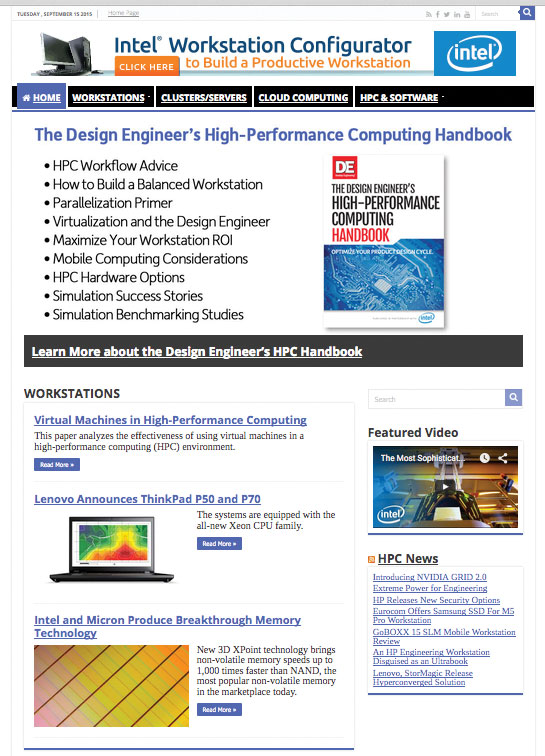The Design Engineer’s High-Performance Computing Handbook: Your Guide to HPC
October 1, 2015
 As the world marks the 50th anniversary of Moore’s Law, it’s difficult not to be amazed and even bewildered by the advances in computing technology. Today we take for granted the computing power now available in cheap, easy-to-use smartphones. Soon, the power of supercomputers will be just as accessible. What will that mean for design engineering?
As the world marks the 50th anniversary of Moore’s Law, it’s difficult not to be amazed and even bewildered by the advances in computing technology. Today we take for granted the computing power now available in cheap, easy-to-use smartphones. Soon, the power of supercomputers will be just as accessible. What will that mean for design engineering?
“While most organizations don’t have access to 36,000 cores today, it won’t be long before these extreme core counts are commonplace,” said Wim Slagter, product manager, High-Performance Computing (HPC), ANSYS in the February 2015 issue of DE. “And even today’s users who are running at much lower core counts will see direct benefits through considerably greater efficiencies. The results will be more amazing products delivered to customers much faster than ever.”
To achieve those results will require more than just advances in computing hardware. It requires accessibility and affordability. Accessibility is enabled by engineering software that takes advantage of those hardware advances while being so easy to use that they require no special knowledge to do so. Affordability is a relative term based on total cost of ownership vs. return on investment, but there’s no disputing the fact that computing prices continue to decrease as computing power increases.
In fact, that’s the point Moore was trying to make when he inadvertently laid down the law via what he later called a wild extrapolation: “My real objective was to get the idea across: We have a technology that is going to make electronics cheap,” says Moore in a video recalling the impetus of his prediction.
What is the HPC Handbook?
The Design Engineer’s High-Performance Computing Handbook is a multimedia resource produced by Desktop Engineering magazine that will show engineering teams how to determine the best combination of computing hardware and engineering software for their needs. The HPC Handbook is a “living” resource that consists of case studies, videos, surveys, white papers and webinars hosted on hpc.deskeng.com; articles in Desktop Engineering magazine; and regularly updated chapters in an expanding electronic handbook. Chapters will include topics such as:
• How to incorporate workstations, in-house clusters/servers and cloud computing into one efficient engineering workflow.
• How to balance workstation components and software preferences to get the most bang for your buck when running specific engineering applications.
• How parallel software paired with modern processors can improve engineering productivity.
• What virtualization means to the design engineer and why IT wants to deploy it.
• An analysis of professional workstations vs. consumer PCs.
• How to tap into additional computing power when on the go.
• A roundup of the latest workstation hardware.
• Simulation success stories that show how HPC enables simulation-led design in various industries.
• Simulation benchmarking studies.
Why the HPC Handbook?
Design engineers are facing a more disruptive technological landscape today than when the term Moore’s Law was coined. The exponential increase in accessible computing power coupled with ubiquitous connectivity has fueled an exponential increase in product complexity. It’s no longer enough to design and develop products. Today’s engineering teams are designing and developing systems — from self-driving cars to lightweight aircraft to all the connected devices that create the Internet of Things.
Advances in simulation-led design, optimization technologies and data management is helping design engineering teams innovate more quickly — and powerful, affordable, accessible engineering computing hardware and software makes it all possible. That’s why The Design Engineer’s High-Performance Computing Handbook was created. Design engineering teams need a constantly evolving reference resource that explains what workstation, clusters and cloud-computing can do when used with the latest simulation, visualization and rendering software.
Subscribe to our FREE magazine, FREE email newsletters or both!
About the Author
DE’s editors contribute news and new product announcements to Digital Engineering.
Press releases may be sent to them via [email protected].








